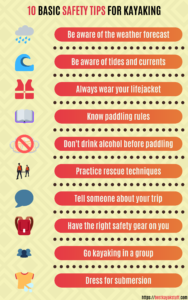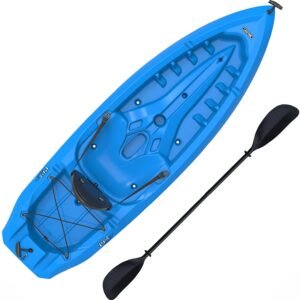Whether you’ve got the best kayak in the world or are a very experienced kayaker, you should keep a couple of kayaking safety tips in mind while in water.
Kayaking certainly is a fun activity. But it also is risky: you are dealing with water, after all, and you can’t really predict what could go wrong during your kayaking trip.
Let’s now see what kayaking safety tips and tricks you should bear in mind while kayaking.

[lwptoc]
Be aware of the weather forecast
The weather may change very quickly. You’ll especially feel those changes while in the water. If you get caught out in bad weather, you certainly won’t have a good time.
In fact, just getting wet is the smallest problem you could find yourself in during bad weather. You could catch a hypothermia, lose your boat, and even downright drown.
That’s why checking out the weather forecast before you go kayaking is exceptionally important. Check out not only the air temperature but also wind direction, speed, and whether it will rain or not.
Don’t trust the weather forecast completely though and instead be aware of your own senses. If you feel that the weather is going bad even though the forecast said it wouldn’t, you should just go back to the shore.
Be aware of tides and currents
Being aware of tides and currents is also extremely important. You should know how strong they are and in which direction they are headed in the water body you are going to kayak in.
Tides can be outright dangerous, while currents could make you unable to make your way back due to exhaustion. Going down the current may seem easy, but it won’t be the same on the way back.
A small difference of a mere 1 mile per hour is, in fact, enough to make your trip back very difficult.
If you will be kayaking in a river, check the USGS current water data. If you don’t find the particular river you will be kayaking on, you could check the data on a nearby river to see whether its flow rate is normal or not.
Alternatively, you could contact the National Park Service to find that out.
If you will be paddling in coastal waters, check out the NOAA map of tides and currents before kayaking.
Always wear your life jacket
We can’t stress enough how necessary it is for you to wear a life jacket at all times, even if you are the most skilled kayaker in the world.
You can’t tell what may happen with you during your kayaking trip, so an additional safety precaution would certainly be appropriate.
According to the American Canoe Association, 48% of kayak fatalities were caused by the kayakers not wearing their flotation devices.
Besides, a US Coast Guard 2017 report tells us that 78% of fatal boating accidents were caused by drowning. Of those victims, 84.5% were not wearing life jackets.
Don’t take off your personal flotation device just because it is uncomfortable. It may be inconvenient, but it could save your life. Picking a kayaking PFD thereby is a must, so make sure to have one on you when paddling.
If you are looking for a life jacket, then our PFD choosing guide may be useful for you.
Know paddling rules
There are some general kayaking regulations and rules that you should be aware of. The American Canoe Association made this handy guide in accordance with federal regulations, so definitely keep them in mind.
Besides, it would be a good idea to contact your local authorities to see whether there are some specific local regulations or not.
Don’t drink alcohol before paddling
While mixing booze with kayaking may seem like a fun idea, you should not do it. The US Coast Guard 2017 report says that alcohol was the leading factor in 19% of the deaths in accidents where the primary cause was known.
The first disadvantage of being drunk is the inability to think clearly. For example, you may not be able to coordinate yourself quickly in case of a sudden weather change.
Secondly, alcohol can speed up the progression of hypothermia. High doses of alcohol may impair thermoregulation, lowering the resistance of the body to cold.
So, simply don’t drink any alcohol before kayaking.
Practice rescue techniques
The risk of turnover is constantly present when kayaking, so you need to know how to reduce its chance and also how to recover from it.
You may want to attend a couple of kayaking lessons to learn how to eject from the boat when upside down and whatnot.
Tell someone about your kayaking trip
Before going out kayaking, tell someone – your friends or relatives – about your plans, especially if you will be kayaking solo. You could also create and share a float plan with the following details:
• The names of everyone in the group and their contact info.
• Put-in and take-out area.
• The planned route.
• Launch and return times, when to notify the authorities if you are late, and your action plan if you are past the deadline.
Share your kayaking plan with as many people as you can. Leave copies of the plan in your kayak and in your car: this would help people find you if you get separated from your kayak.
Have the right safety gear on you
To ensure a safe kayaking trip, have the following gear on you:
Must-haves:
• Personal flotation device (PFD).
• Whistle to draw attention towards you.
• Bilge pump to remove water from inside the kayak (if you have a sit-in kayak).
• Spray skirt to keep the water out of the kayak (if you have a sit-in kayak).
• Dry bag to keep your water-sensitive items safe.
Optional:
• Paddle float to use for self-rescue in case of a turnover.
• Float bags.
• Change of clothes in a dry bag.
• First aid kit in a dry bag. You could either buy one for paddling or make your own.
• Straight paddling knife clipped to the PFD to help you cut lines or straps.
• Towline to tow other paddlers.
• Throw line bag. This would be useful if you can’t approach other kayakers safely to help them.
• Paddle leash to tether your paddle to prevent it separating from the kayak.
• Signal flares.
• Compass/GPS.
• Radio to keep an eye on weather updates or to call for help.
Go kayaking in a group
Whether you are a beginner or not, there should at least be one other kayaker with you. In a group, you will be able to keep an eye on each other and be more visible. And if you get into trouble, the risk of things going very dangerous would be much lower.
Dress for submersion
While the primary cause of kayaking fatalities is drowning, you shouldn’t leave hypothermia out of attention. The body heat can be lost 25 times faster in cold water than in cold air, so you should be dressed for submersion.
To dress correctly, assume that you are going to get wet or even be submerged in cold water. Additionally, make sure to have changes with you so you don’t sit completely wet during your kayaking trip.
To get an idea of what you should be wearing, make sure to check our guide on dressing before kayaking. Besides, you would also want to know how to pick a great spot for kayaking.


